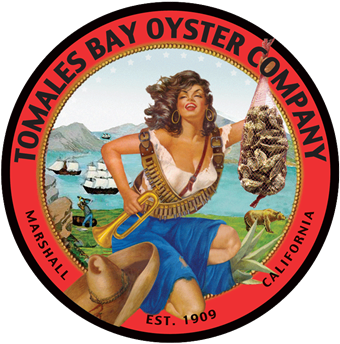The Aussie Gal Running One Of California's Oldest Oyster Companies
Meet Heidi Gregory of the Tomales Bay Oyster Company
Heidi Gregory was never going to work in a cubicle. Mother Nature was always going to be her office. Heidi, 46, was an international travel guide taking tourists on biking and hiking trails across Australia and Europe, but now she’s working on the water instead of traversing mountains.
“I love nature. I love being out in any weather and seeing what’s happening out there, testing the water and being on the boat with the wind in your hair, salt flying and having crusty salty eyebrows at night. I like being in touch with the earth, it makes me feel connected and grounded,” she says.
Heidi’s father, Tod Friend, used to run Tomales Bay Oyster Company and taught her all he knew about oyster farming. She took over the farm after Tod had a tragic boat accident.
“Dad passed away, while on the bay working. I came back and have now been running the farm for the last three years,” she says.
“I’d always helped him out. I worked summers and he was always really good at not caring what my gender was, allowing me to drive the boat and doing a lot of muddy, yucky things and teaching me about the ocean. I always loved the ocean but being an oyster farmer wasn’t on my radar then. Mind you, I always knew that if we continued, and the ocean was still surviving, I would try to help my dad out once he was too old to work the farm. Not that he would ever have admitted to that!”
Heidi and her brother Shannon working on the farm with Tod (centre)
Heidi, along with Cathryn Irving, Tod’s girlfriend, now run Tomales Bay Oyster Company and are one of the few female management teams in the area. The company is now over 111 years old and is the oldest continually operating oyster company in California.
“We mainly grow a Pacific oyster and Kumamoto, which is a Japanese oyster. It’s a really small, delicate oyster that has a different flavour. It’s more of a buttery finish whereas the Pacific is saltier and brinier,” she says.
“It took a bit of time to be able to grow the Kumamoto oysters in the bay. It’s a very pedantic oyster and difficult to grow, because if the water temp changes two degrees it will die, if you move it from one area to another it can freeze up and won’t grow so well. It’s really just a pain in the arse.”
So, what’s the pay-off?
“It’s a delicacy, you can pay US$4-$6 for them in a restaurant. It’s fun too, to do a bit of something different,” Heidi says.
Heidi learnt her trade from her dad and, typical of the laid-back Aussie attitude, is happy to admit she is “just winging it.” And she’s doing a great job of it.
“I’m not educated in marine biology, I’m just winging it, but I’m always learning every day and discovering new things and trying out new stuff. If doesn’t work, I throw it out the window,” she says.
“It gives you flexibility to have more of an evolving thought process and the ability to not be trapped into a certain stigma of what this is what oyster farmers do. In that way, you’re a bit more open to new ideas, which is very important given the challenges that farming throws at you.”
That feeling was reinforced when wildfires hit the coast of California recently.
“A couple of weeks there we had really hard times working out in the smoke, we all wore masks but it was tough on the body. Farmers work outside every day and it’s a bloody hard life at the best of times. You really have to love it,” she says.
Heidi is still waiting to see what the effect of the wildfires will have on her oysters.
“When I was out walking on the bay, the foam that was coming up was charcoal grey when it’s normally white and I just wonder what that will do to flavour of the oysters. We won’t see the effects of it for a few months, because it also depends on wind and current. Maybe we’ll produce the smoky Pacific oyster of 2020,” she says.
“I don’t think the smoke would have affected the oysters that much though. We’re going to be OK in that sense. The hardest thing for us was in February 2019, we had nine inches (22cm) of rain in two days and a big flood out over one of our leases and over one million oysters died.
A masked Heidi & crew working under smoke filled skies.
“We’re always watching and worried about Mother Nature. The rain has been sporadic because we’re in a drought and then we get a massive flood. Temperatures in the bay are changing, the PH levels and salinity levels are noticeably different. It’s a huge telltale sign of what’s happening, shellfish are on the bottom of the ocean and anything that lives on the bottom is going to be the most affected by climate change.”
When Tod died, Heidi was left grieving her dad and floundering when it came to the farm.
“Dad passed and he had everything in his head. I didn’t really know what was out there, the crew kind of did, but how do you track everything? Where is it in the cycle of small or medium? How do you know when to fix line? What needs maintenance? Where to put seed?” Heidi says.
“I didn’t know about any of it. I asked a few other oyster farmers who told me to write it on a whiteboard, but someone leant up against it and rubbed it off. I was looking through the Pacific Shellfish Growers Association book and saw a little ad for SmartOysters and thought, ‘Yeah, what a brilliant idea. And they’re Australian; sick.’ I did my schooling in Toowoomba in Queensland and mum lives in Sydney. I came here when I was 25 to hang out with my dad.
“As we had nothing recorded at the start, I had to go around and count every single bag, GPS the whole entire lease of 217 acres (87 hectares) and then give it all to Col who put it in a map, sent it to us and then we had some tutorials of how to use the app. It was really easy to pick up and like anything, it’s continually evolving.
“Ewan and Col are working with us to add a few more things that will work well for our farm. They also helped us with our crew who speak Spanish and worked out some ways to interpret the instructions for them.
“They’re always willing to go that extra mile to help us out and I know they do that for any farmer in unique circumstances, which is brilliant.”
Tod, Heidi and the TBOC crew
Head on over to the Tomales Bay Oyster Co’s website to learn more about this fantastic farm. If you’re in the area, don’t forget to call in on them to buy and taste their delicious oysters! They sell an excellent range of TBOC merchandise too. Opening hours and contact details are listed on the website.
You can access the website here.





